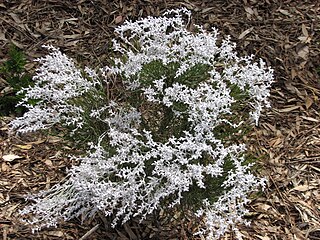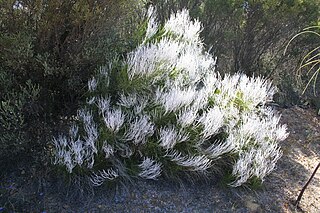
Conospermum is a genus of about 50 species in the family Proteaceae that are endemic to Australia. Members of the genus are known as smokebushes - from a distance, their wispy heads of blue or grey flowers resemble puffs of smoke. They have an unusual pollination method that sometimes leads to the death of visiting insects. They are found in all Australian states, though most occur only in Western Australia. Smokebushes are rarely cultivated, though the flowers of several Western Australian species are harvested for the cut flower industry.
Conospermum glumaceum, commonly known as hooded smokebush, is a shrub endemic to Western Australia.

Conospermum stoechadis, commonly known as common smokebush, is a shrub endemic to Western Australia.
Conospermum stoechadis subsp. sclerophyllum is a shrub endemic to Western Australia.

Conospermum caeruleum, commonly known as blue brother, is a shrub in the family Proteaceae and is endemic to the south west of Western Australia. It is a prostrate shrub with small, dense heads of blue, rarely pink flowers and usually grows in heavy soils subject to flooding.
Conospermum amoenum, commonly known as blue smokebush, is a shrub endemic to Western Australia
Conospermum bracteosum is a shrub endemic to Western Australia.
Conospermum canaliculatum is a shrub endemic to Western Australia.
Conospermum capitatum is a shrub endemic to Western Australia.

Conospermum crassinervium, commonly known as the summer smokebush or tassel smokebush, is a shrub endemic to Western Australia.

Conospermum densiflorum, commonly known as crown smokebush, is a shrub endemic to Western Australia.
Conospermum filifolium is a shrub endemic to Western Australia.

Conospermum nervosum is a shrub of the Proteaceae that is endemic to Western Australia.

Conospermum scaposum is a shrub endemic to Western Australia.
Conospermum sigmoideum is a shrub endemic to Western Australia.
Conospermum teretifolium, commonly known as the spider smokebush, is a shrub endemic to Western Australia.
Conospermum toddii, commonly known as the victoria desert smokebush, is a shrub endemic to Western Australia.

Conospermum triplinervium, commonly known as the tree smokebush or elk smokebush, is a tree or shrub endemic to Western Australia.

Conospermum undulatum is a shrub in the Proteaceae family, endemic to Western Australia, first described by John Lindley in 1839.
Conospermum wycherleyi is a shrub endemic to Western Australia.









